Abstract
The use of aqueous carbonate as an inorganic absorbent is not only inexpensive but also stable and environmentally friendly. However, the regeneration processes for aqueous carbonate sorbents require high regeneration heat duty; this energy intensity makes their wide utilization unaffordable. In this work, a low-temperature, energy-saving, and environmentally friendly carbon dioxide desorption method has been investigated in potassium bicarbonate-water-alcohol solutions. The addition of alcohol, particularly isopropanol, to the potassium bicarbonate-water solution can significantly increase carbon dioxide desorption capacity. The potassium bicarbonate-water-isopropanol solution used in this study (36 wt % isopropanol) resulted in 15.2 mmol of carbon dioxide desorption within 2400 s at 80 °C, which was 2000-fold higher than the potassium bicarbonate-water-solution. This research demonstrates a water-lean solvent-based carbon dioxide removal route with the potential to be economical, environmentally safe, and energy-efficient. CO2 sequestration, capture, and utilization technologies will play a key role in reducing CO2 emissions. The excellent desorption kinetics and relatively moderate desorption temperatures (80 °C) of water-lean solvent could help in reducing the cost of CO2 capture, particularly in terms of the heat demand at the regenerator.
1. Introduction
Emissions of greenhouse gases (GHG) have increased substantially since the start of the industrial revolution. The rising levels of carbon dioxide (CO2) in the atmosphere have received significant attention due to increased global temperatures and noticeable climate change [1]. CO2 capture and storage (CCS) or utilization technologies reduce GHG emissions in the atmosphere to minimize their warming effects and slow climate change. Post-combustion capture removes CO2 from flue gas (composed primarily of 10% CO2, H2O vapor, O2, N2, trace gases, and fly ash) after burning fossil fuel. At present, conventional coal-fired power plants combust primary coals to directly generate power [2]. Thus, post-combustion capture is the most viable choice for existing coal-fired power plants.
The implementation of post-combustion CO2 capture from fossil fuel-fired power plants requires using different methodologies, including solid sorbents, membranes, and solvents [3]. Membrane-capture technologies, solid inorganic sorbents (such as CaO, K2CO3, and Na2CO3), and solid organic sorbents (such as metal–organic frameworks (MOFs) and amine-modified biochar) are at various stages of development and proximity to commercialization [4,5,6,7,8,9]. The major disadvantage of membrane-capture technologies is the increased mass transfer resistance, especially when membranes are wetted [10]. Likewise, the solid inorganic sorbents have a disadvantage because there is a decrease in reactivity during multiple absorption/regeneration cycles at low temperatures (<200 °C) [11,12]. The adsorption capacity of biochar for CO2 in flue gas is low, but amine-modified biochar has good absorption ability and industrial application prospects [7].
Currently, the implementation of an absorption–desorption process using a chemical solvent is the most developed and adequate process for deployment in the near- to middle-term [13]. The main drawback of the solvent-based CO2 capture process is that the consumption of heat energy for solvent regeneration, referred to as regeneration heat duty (Qreg, kJ/kg CO2), is very high. For example, the Qreg of monoethanolamine (MEA)-based technology accounts for about 70% of the overall operating cost [14]. Thus, the Qreg is a critical parameter in the post-combustion CO2 capture process. The Qreg consists of [15]: (i) sensible heat (Qsen) for raising the temperature of the solution, (ii) absorption heat (Qabs) for desorbing the CO2 from the solution, and (iii) vaporization heat (Qvap) for evaporating liquid water to vapor for CO2 stripping.
During the past few decades, water-lean solvents have been extensively studied as a possible method of reducing the consumption of commercial absorbents with high energy consumption demands [16,17]. Compared with water-based solvents, water-lean solvents have similar chemical selectivity but far lower specific heat, due to their lack of water. In principle, significant improvements could be achieved in regeneration energy. Alcohols [18,19], polyalcohols [20], and mixtures of glycol ethers [21] are popular organic solvents that lower both the required reaction temperature and solvent regeneration energy. Lin et al. [22] reported that the Qreg of PZ/DETA/H2O was 2.99 GJ/ton CO2, whereas the Qreg of PZ/DETA/MeOH/H2O was 1.84 GJ/ton CO2 at 120 °C. The addition of an organic alcohol (MeOH) reduced the Qreg by 38.5%. Among the many strategies to reduce Qreg, the use of new and more effective water-lean solvents has promise, since they directly affect the capture performance and operating conditions. In addition, it is easy to apply these solvents to existing CO2 capture plants [23]. Alcohols are versatile high-purity oxygenated chemical solvents that provide unique combinations of solvency and solubility, with complete or at least partial miscibility with water and the ability to dissolve a range of polar components, including other organic solvents. Short-chain alcohols (C1–C5) are categorized as green solvents since they can be obtained by fermenting renewable resources, such as sugars, starches, or lignocellulosics; they represent a low-cost solvent compared with other solvents [24,25].
Currently, amine-based organic sorbents are the leading CO2 capture technology in the industry [26,27]. Compared with organic absorbents, inorganic sorbents are not only inexpensive but also stable and environmentally friendly [12,28,29]. However, like any other CO2 solvent sorbents, their slow CO2 desorption kinetics make their widespread utilization unaffordable, considering that the energy consumption of the CO2 desorption step accounts for 70–80% of the total energy needed for the overall CO2 capture process [30]. Therefore, this current research focuses on investigating the significant effect of alcohols on promoting water-lean potassium bicarbonate (KHCO3) solution decomposition on CO2 desorption kinetics.
2. Materials and Methods
2.1. Materials
Ethanol (EtOH) (Sigma-Aldrich, St. Louis, MO, USA, ≥98%), isopropanol (IPA) (Alliance Chemical, Taylor, TX, USA, ≥99%), methanol (MeOH) (Fisher Chemical, Waltham, MA, USA, ACS grade), 1-butanol (Fisher Chemical, Waltham, MA, USA, ACS grade), H2O, and KHCO3 (Chem-Impex International Inc., Wood Dale, IL, USA, ≥99.7%) were utilized without further purification. Mixed gas (10% CO2, 10% O2, 80% N2 molar concentration, Praxair, Burr Ridge, IL, USA) was used to simulate flue gas, and pure N2 (Praxair) was used as a purge gas. Mass flow controllers (RED-Y, Sierra, Monterey, CA, USA), with a ±1% accuracy, were used to control the flow of gases from the gas cylinders to the reactor. A gas analyzer (ZPA, CAI, Orange, CA, USA) was used to monitor gas levels, and a paperless recorder (DataChart 2000, Monarch, Amherst, NH, USA) was used to collect and read the data. The accuracies of these instruments were ±0.5 and ±0.1% of the full scale, respectively. The estimated error for the data reported in the results section is no more than 2%.
2.2. Methods
CO2 desorption tests were performed using the setup shown in Figure 1. Each trial run started with 200 g of solvent solution. Blank trials were prepared with 10 wt % KHCO3 and 90 wt % H2O. Tests with and without the addition of different alcohols were performed to evaluate the effect of alcohols on desorption. Thus, the remaining trials were prepared with 10 wt % KHCO3, (90−X) wt % H2O, and X wt % alcohol (X = 18, 27, 36, and 45).
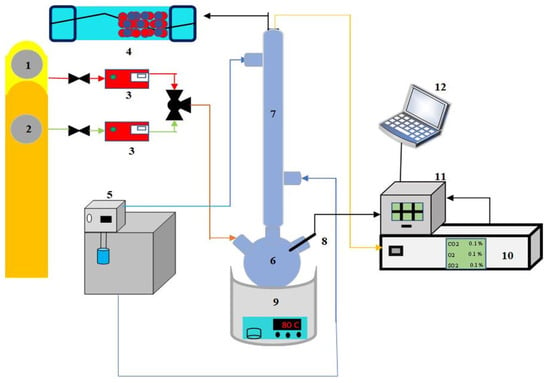
Figure 1.
CO2 capture experiment setup. (1) N2 cylinder, (2) mixed gas cylinder, (3) mass flow controller, (4) desiccator, (5) thermostatic bath, (6) 500 mL three-necked flask, (7) condenser, (8) thermocouple, (9) heater/stirrer, (10) gas analyzer, (11) paperless recorder, (12) laptop.
Pure N2 (1) was used during the CO2 desorption step to flush out residual gas at the end of each desorption experiment. The mixed gas (2) was also used to calibrate the equipment twice per week to obtain accurate results. Mass flow controllers (3) were used to regulate the gas feed rates. The CO2 absorption and desorption steps were performed in a 500 mL reactor (6), surrounded by an adjustable electric heater (9).
- (i)
- Absorption: The CO2 absorption experiments were conducted at a constant laboratory room temperature of 20 °C. A cooling liquid at 5 °C from the thermostatic bath (5) was circulated through the condenser (7) to return vapors to the reactor. A desiccator (4) was used to trap any fugitive water vapor. The simulated flue gas (10 vol % CO2, 10 vol % O2, and 80 vol % N2) with a flow of 500 mL/min was employed for the CO2 absorption. The mixed gas reactor feed percolated into the solution through a muffler, and the outlet gas CO2 concentration was measured to determine the absorption capacity. The absorption step was conducted for 60 min.
- (ii)
- Desorption: The CO2 desorption experiments were performed by heating the solution to 80 °C. A cooling liquid at 5 °C from the thermostatic bath (5) was circulated through the condenser (7) to return the vapors to the reactor. A desiccator (4) was used to trap any fugitive water vapor. A flow of 500 mL/min of N2 was used to carry CO2 gas from the solution, and the pulled gas was analyzed. The desorption step was conducted for 40 min.
- (iii)
- Loading estimation: “” (mmol CO2) is the amount of CO2 absorbed during the entire absorption experiment. It was calculated via the following material balance [31]:
“” (mmol CO2) is the amount of CO2 desorbed during the entire desorption experiment. It was calculated via the following material balance [31]:
Here, Q is the total flow rate (mL/min); ρCO2 is the CO2 density at 20 °C and 101.325 kPa (kg/m3); MCO2 is the molecular weight of CO2 (kg/mol); Cin and Cout are the inlet and outlet CO2 concentrations (vol %), respectively. T denotes the reaction temperature (K), and T0 is 273 K.
“CO2-rich/lean loading” is the amount calculated by dividing the number of moles of CO2 by the number of moles of KHCO3. “Maximum capacity” is the amount calculated by dividing the number of moles of CO2 by the mass of solvent (alcohol + water).
The desorbed solvents from the CO2 desorption experiments were analyzed using Raman spectroscopy. Sample spectra were collected at 5-minute intervals using a Horiba MacroRAM Raman spectrometer (Irvine, CA, USA) with a 785 nm excitation.
3. Results
3.1. Effects of Different Alcohols on CO2 Absorption and Desorption
CO2 capture experiments with 200 g sorbents containing 10 wt % KHCO3, 45 wt % H2O and 45 wt % alcohols were performed using the setup shown in Figure 2. The CO2 absorption and desorption with and without the use of MeOH, EtOH, IPA, and butanol were conducted to evaluate the effect of alcohols on the CO2 capture performance of KHCO3−H2O−45 wt % alcohol sorbents. As shown in Figure 2a, all the curves nearly overlap each other; the amount of CO2 absorbed by the KHCO3−H2O−45 wt % alcohol sorbents after the absorption step is ~0.42 mmol and the rates of CO2 absorption are near 0 mmol/s after 200 s (Figure 2b). The loading for CO2 in KHCO3−H2O−alcohol solvent is about 0.5; alcohol does not add additional CO2 loading. This work focuses on improving the desorption behavior of inorganic sorbent with a combination of alcohols and DI water. Using KHCO3−H2O−alcohol solvent can avoid the desorption changes being affected by inconsistent absorption, and the effect of alcohol on desorption is independent [29,32,33]. In the following section, we will investigate the effect of alcohols on promoting aqueous KHCO3 decomposition and CO2 desorption kinetics.
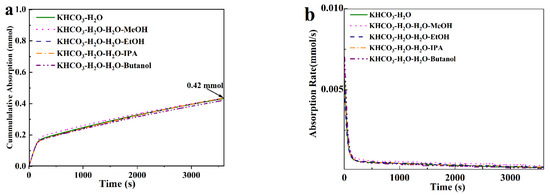
Figure 2.
The effects of different alcohols on CO2 absorption in KHCO3−H2O and KHCO3−H2O−45 wt % alcohol solutions: (a) effects of alcohols on the quantities of absorbed CO2. (b) The rates of CO2 absorption.
Table 1 summarizes the effects of alcohols on the CO2 desorption conditions at 80 °C under 2400 s. It was expected that alcohols would promote increased CO2 desorption capacity, as reported in a previous study [19]. As shown in Table 1, KHCO3−H2O−alcohol sorbents show increased amounts of CO2 desorption within the 2400 s period. Similarly, our results demonstrate that adding alcohols, especially MeOH, EtOH, and IPA, to the KHCO3−H2O solution increases the CO2 desorption capacity. According to Table 1, KHCO3−H2O−IPA has the highest CO2 desorption capacity, compared to the other combinations.

Table 1.
Summary of the effects of alcohol on CO2 desorption with KHCO3−H2O−alcohol solutions (10 wt % KHCO3, 45 wt % H2O, 45 wt % alcohol) at 80 °C under 2400 s.
The CO2 desorption trials were conducted in five distinct experiments, as previously described. One experiment involved running a blank trial with a KHCO3−H2O solution (10 wt % KHCO3) to establish a baseline. The four other experiments used KHCO3−H2O−alcohol solution (10 wt % KHCO3, 45 wt % H2O, and 45 wt % alcohol). From these experiments, the trend of the effects on the desorption rate of the alcohols was established. At least two trials of each method were performed, and the average desorption values were used for data analysis. Figure 3 shows the cumulative CO2 desorbed during the desorption experiments. As shown, the addition of alcohols increased the amount of CO2 that was desorbed. KHCO3−H2O−EtOH, KHCO3−H2O−MeOH, and KHCO3−H2O−butanol solutions desorbed approximately 7.0, 2.9, and 3.6 × 10−2 mmol of CO2, respectively. However, the KHCO3−H2O−IPA solution resulted in 14.9 mmol of CO2 desorption within 2400 s. According to the previous literature, the addition of alcohols offers several advantages in the CO2 desorption process. First, alcohols can change the reaction pathway by forming R-OCO2− instead of HCO3− (which is difficult to decompose) [19]. Second, alcohols can reduce the dielectric constant of the solvent and, thus, are able to reduce the dissociation constant (and basic strength) of the sorbent, which allows for the release of acidic CO2 from the absorbent at a lower temperature. The reduced basic strength may also lower the activation energy of CO2 desorption [34]. The regeneration heat duty includes three terms: the sensible heat, the heat of water evaporation, and the heat of CO2 desorption. Low-carbon alcohols (C1–C3 alcohols) have a lower enthalpy of vaporization than water. Besides the change in CO2 solubility and kinetics, another advantage of replacing some of the water with a more volatile substance is that the boiling temperature of the system is lowered [35]. Finally, the regeneration heat duty of KHCO3 solutions can be reduced because adding alcohols to an aqueous KHCO3 solution shifts the equilibrium isotherms at high temperatures to lower loadings, thus facilitating the desorption of CO2 [35]. The boiling points of MeOH, EtOH, IPA, and butanol are 64.7, 78, 82.5, and 117.7 °C, respectively. The cumulative CO2 desorption amounts of KHCO3−H2O solution after adding alcohol are not related to boiling-point order. The effect of alcohol may be a combination of the above three functions. The boiling point of butanol is much higher than the desorption temperature and, since it shows almost negligible desorption, it illustrates the important role of the regeneration heat duty.
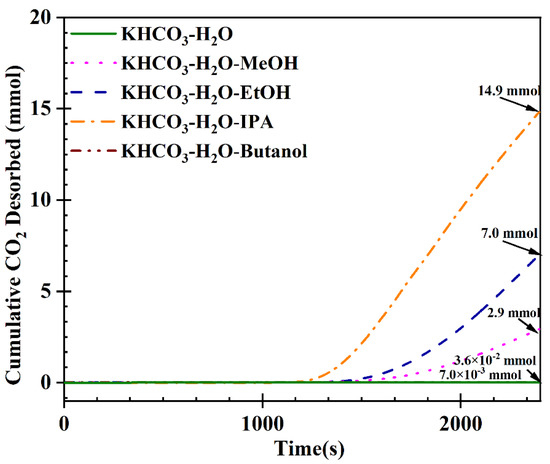
Figure 3.
Effect of different alcohols on CO2 desorption in KHCO3−H2O and KHCO3−H2O−alcohol solutions.
Although the quantity of CO2 desorbed is important, the desorption rate reflecting the CO2 kinetics is more critical when applying the sorption-based CO2 capture technology because it affects the capital and operating costs [19]. Figure 4 shows the desorption rates, based on the type of alcohol used in the KHCO3−H2O−alcohol solution. As shown, the addition of alcohols resulted in varying CO2 desorption rates. Specifically, KHCO3−H2O−EtOH, KHCO3−H2O−MeOH, and KHCO3−H2O−butanol have desorption rates of 1.1 × 10−2, 4.9 × 10−3, and 5.0 × 10−5 mmol/s, respectively. However, the KHCO3−H2O−IPA solution reached a peak desorption rate of 1.5 × 10−2 mmol/s at 1690 s. Therefore, it is concluded that the KHCO3−H2O−IPA solution achieves the highest desorption when compared to the other alcohols used in the experiment. As a result, the KHCO3−H2O−IPA solution was selected for further study.
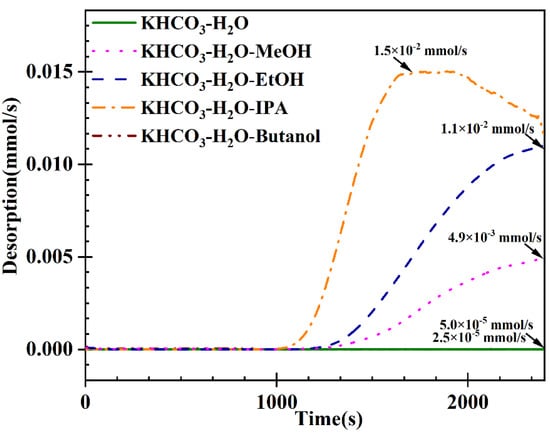
Figure 4.
CO2 desorption rates in KHCO3−H2O and KHCO3−H2O−alcohol solutions.
3.2. Effects of Different Isopropanol Concentrations on CO2 Removal
KHCO3−H2O−IPA solutions with IPA concentrations ranging from 0 to 45 wt % were used to investigate the effect of IPA concentration on CO2 removal. As shown in Figure 5, there was a significant difference in the amount of CO2 desorbed by the 18- and 45-wt % IPA solutions. The cumulative CO2 desorption amounts of 18 wt %, 27 wt %, 35 wt %, and 45 wt % IPA solution were 2.6, 4.8, 15.2, and 14.9 mmol, respectively. Figure 5 indicates the increase in desorption capacity as the concentration of the IPA increases, while Figure 6 illustrates the improvement of KHCO3−H2O−IPA desorption kinetics when 0 to 45 wt % IPA solutions are used. As can be seen, the 18- and 27-wt % IPA solutions yielded desorption rates of 3.9 × 10−3 and 5.9 × 10−3 mmol/s, respectively, while the 36- and 45-wt % IPA solutions yielded desorption rates of 1.4 × 10−2 and 1.5 × 10−2 mmol/s, respectively. The cumulative CO2 desorption amounts of the 36-wt % IPA solution were slightly higher than the 45-wt % IPA solution. Compared with the 45-wt % IPA solution, the 36-wt % IPA solution had a slightly lower desorption rate. From the cost and effect ratio, it can be concluded that 36 wt % is the optimal concentration; thus, it was selected for further study.
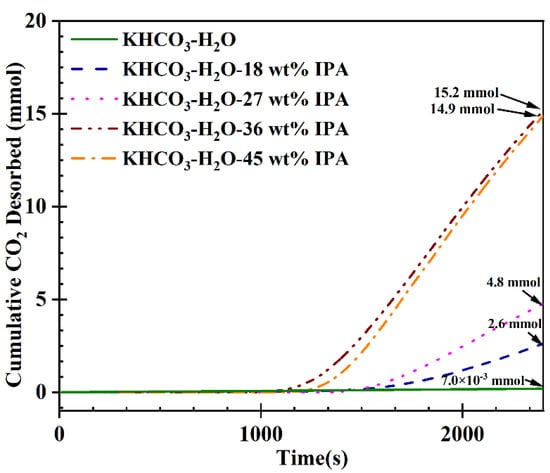
Figure 5.
Effect on IPA concentration on CO2 desorption in KHCO3−H2O and KHCO3−H2O−IPA solutions.
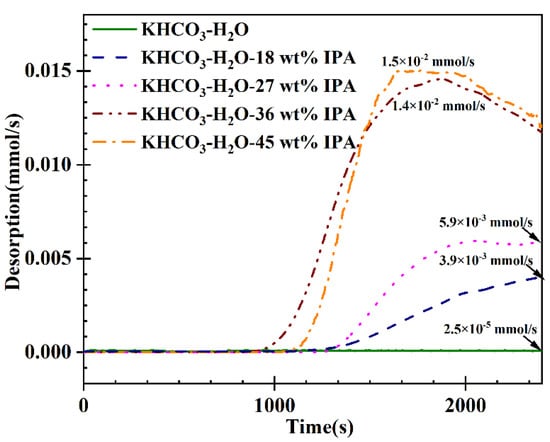
Figure 6.
CO2 desorption rates in KHCO3−H2O and KHCO3−H2O−IPA solutions.
CO2 desorption data from the KHCO3−H2O−IPA solution with varying amounts of IPA are shown in Table 2. The rates of desorption observed for 36 wt % and 45 wt % were significantly higher than the rates for 18 and 27 wt %. These experiments were performed to see the effects of different concentrations of IPA on CO2 desorption. According to the results, CO2 desorption varied depending on the concentrations of IPA, thus proving that different concentrations of IPA affect CO2 desorption. According to Figure 6, 36 wt % IPA is likely the best option for CO2 removal from KHCO3−H2O−IPA solutions. According to the data, even though 45 wt % resulted in a slightly higher amount of CO2 desorbed, 36 wt % had a higher desorption rate. As a result, KHCO3−H2O−IPA (36 wt % IPA) solution was considered the optimum concentration for the experiment. Therefore, further experiments were performed on 36 wt % IPA solution.

Table 2.
Summary of the effects of IPA on CO2 desorption with KHCO3−H2O−IPA solutions at 80 °C under 2400 s.
4. Material Analysis
4.1. Raman Spectroscopy
KHCO3−water−IPA solutions were tested through Raman spectroscopy (Figure 7). The peaks at approximately 1005 cm−1 and 1060 cm−1 represent the presence of HCO3− and CO32−, respectively [36]. By comparing the peaks with and without IPA, it can be determined whether the presence of IPA in solution influences the rate of desorption. The intensity of the HCO3− peak at 1005 cm−1 when IPA is present decreases at a noticeably higher rate (Figure 7a) than when the IPA is not present (Figure 7b). Additionally, the increase in peak intensity at 1060 cm−1 indicates that the rate of K2CO3 formation is significantly higher with the IPA as opposed to the rate without. The Raman analysis, therefore, confirms that CO2 demonstrates increased desorption kinetics when the alcohol co-solvent is present.
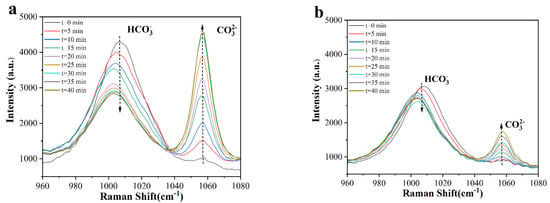
Figure 7.
Raman spectra of CO2 desorption. Measurements were taken at five-minute intervals from time 0 min to 40 min. (a) KHCO3−water−IPA solution (36 wt % IPA). (b) KHCO3−water solution.
Based on the Raman results, a possible evolution mechanism is proposed in Figure 8. First, potassium bicarbonate dissociates into cations and anions once it is fully dissolved in water (R1). When the KHCO3 solution is heated, it decomposes into K+, CO32−, CO2, and H2O (R2). IPA can change the reaction pathway by forming C3H7OCO2− and H2O (R3), thus lowering the activation energy required for CO2 desorption.
KHCO3(aq) ⇋ K+(aq) + HCO3− (aq)
2K+(aq) + 2HCO3−(aq) ⇋ 2K+(aq)+ CO32−(aq)+ CO2(g)↑ + H2O(aq)
3K+(aq) + 3HCO3−(aq) + C3H7OH(aq) ⇋ 3K+(aq) + CO32−(aq) + C3H7OCO2−(aq) + CO2(g)↑ +2H2O(aq)

Figure 8.
Major reaction pathways of CO2 capture with KHCO3−H2O and KHCO3−H2O−IPA solutions.
4.2. Cyclic Stability
The findings in this study generated two practical questions: firstly, can the KHCO3−H2O−IPA solution (36 wt % IPA) be sustained during multiple regeneration cycles? Secondly, how stable is the KHCO3−H2O−IPA solution? In order to answer these questions, 12 cyclic regeneration experiments were performed (Figure 9). The experimental conditions for cyclic stability involved 40 min of desorption, followed by absorption for 60 min for each cycle. After 12 cycles, the CO2 desorption capacity retention (capacity 12th/capacity 1st) was 96.7%. These results suggest that the KHCO3−H2O−IPA solution is reasonably stable and can be used in practical situations.
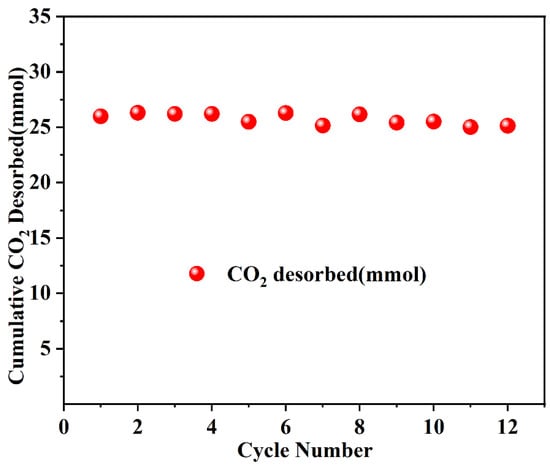
Figure 9.
Stability of KHCO3−H2O−IPA solution (36 wt % IPA).
5. Conclusions
Different alcohol solutions were prepared using KHCO3, H2O, and alcohols to study their CO2 desorption performance. A KHCO3−H2O−IPA solution (10 wt % KHCO3, 54 wt % water, and 36 wt % IPA) proved to be the best mixture for CO2 capture because it increased the amount of CO2 desorbed at room temperature from 7.0 × 10−3 mmol (blank solution) to 15.2 mmol. During 12 cycles of CO2 desorption/sorption (CO2 10% partial pressure) reaction, the desorption capacity showed no significant change, proving that the KHCO3−H2O−IPA solution remained stable after multiple cycles. These results demonstrate that the addition of IPA can significantly improve the CO2 desorption of KHCO3 solutions and that a water-lean solvent CO2 removal route can be both economical and energy-efficient.
Author Contributions
Writing—reviewing and editing, L.W.; writing—original draft preparation, M.S.; data curation, J.L. and A.L.; methodology, R.S. and Z.S.; investigation, M.A. (Matthew Aro) and N.W.; project administration, R.D.; resources, M.A.Z. and M.A. (Malek Alkasrawi); supervision, S.T. All authors have read and agreed to the published version of the manuscript.
Funding
This research received no external funding.
Institutional Review Board Statement
Not applicable.
Informed Consent Statement
Not applicable.
Data Availability Statement
Not applicable.
Acknowledgments
The authors gratefully acknowledge Minnesota’s Discovery, Research, and Innovation Economy Program for their financial support of this work.
Conflicts of Interest
The authors declare no conflict of interest.
References
- Davis, S.J.; Caldeira, K.; Matthews, H.D. Future CO2 Emissions and Climate Change from Existing Energy Infrastructure. Science 2010, 329, 1330–1333. [Google Scholar] [CrossRef] [PubMed]
- Asif, Z.; Chen, Z.; Wang, H.; Zhu, Y. Update on air pollution control strategies for coal-fired power plants. Clean Technol. Environ. Policy 2022, 24, 2329–2347. [Google Scholar] [CrossRef] [PubMed]
- Li, B.; Duan, Y.; Luebke, D.; Morreale, B. Advances in CO2 capture technology: A patent review. Appl. Energy 2013, 102, 1439–1447. [Google Scholar] [CrossRef]
- Berger, E.; Hahn, M.W.; Przybilla, T.; Winter, B.; Spiecker, E.; Jentys, A.; Lercher, J.A. Impact of solvents and surfactants on the self-assembly of nanostructured amine functionalized silica spheres for CO2 capture. J. Energy Chem. 2016, 25, 327–335. [Google Scholar] [CrossRef]
- Khalilpour, R.; Mumford, K.; Zhai, H.; Abbas, A.; Stevens, G.; Rubin, E.S. Membrane-based carbon capture from flue gas: A review. J. Clean. Prod. 2015, 103, 286–300. [Google Scholar] [CrossRef]
- Wang, Y.; Hu, X.; Guo, T.; Tian, W.; Hao, J.; Guo, Q. The competitive adsorption mechanism of CO2, H2O and O2 on a solid amine adsorbent. Chem. Eng. J. 2021, 416, 129007. [Google Scholar] [CrossRef]
- Tian, W.; Wang, Y.; Hao, J.; Guo, T.; Wang, X.; Xiang, X.; Guo, Q. Amine-Modified Biochar for the Efficient Adsorption of Carbon Dioxide in Flue Gas. Atmosphere 2022, 13, 579. [Google Scholar] [CrossRef]
- Zhao, P.; Zhang, G.; Yan, H.; Zhao, Y. The latest development on amine functionalized solid adsorbents for post-combustion CO2 capture: Analysis review. Chin. J. Chem. Eng. 2021, 35, 17–43. [Google Scholar] [CrossRef]
- Wang, L.; Li, J.; Xu, J.-B.; Chang, A.-M.; Bian, L.; Gao, B.; Liu, K.-T. Bi2Fe4O9 submicron-rods synthesized by a low-heating temperature solid state precursor method. J. Alloys Compd. 2013, 562, 64–68. [Google Scholar] [CrossRef]
- Zhao, S.; Feron, P.H.M.; Deng, L.; Favre, E.; Chabanon, E.; Yan, S.; Hou, J.; Chen, V.; Qi, H. Status and progress of membrane contactors in post-combustion carbon capture: A state-of-the-art review of new developments. J. Membr. Sci. 2016, 511, 180–206. [Google Scholar] [CrossRef]
- Lee, S.C.; Choi, B.Y.; Lee, T.J.; Ryu, C.K.; Ahn, Y.S.; Kim, J.C. CO2 absorption and regeneration of alkali metal-based solid sorbents. Catal. Today 2006, 111, 385–390. [Google Scholar] [CrossRef]
- Wang, J.; Huang, L.; Yang, R.; Zhang, Z.; Wu, J.; Gao, Y.; Wang, Q.; O'Hare, D.; Zhong, Z. Recent advances in solid sorbents for CO2 capture and new development trends. Energy Environ. Sci. 2014, 7, 3478–3518. [Google Scholar] [CrossRef]
- Han, K.; Ahn, C.K.; Lee, M.S.; Rhee, C.H.; Kim, J.Y.; Chun, H.D. Current status and challenges of the ammonia-based CO2 capture technologies toward commercialization. Int. J. Greenh. Gas Control. 2013, 14, 270–281. [Google Scholar] [CrossRef]
- Zhang, X.; Fu, K.; Liang, Z.; Rongwong, W.; Yang, Z.; Idem, R.; Tontiwachwuthikul, P. Experimental studies of regeneration heat duty for CO2 desorption from diethylenetriamine (DETA) solution in a stripper column packed with Dixon ring random packing. Fuel 2014, 136, 261–267. [Google Scholar] [CrossRef]
- Oexmann, J.; Kather, A. Minimising the regeneration heat duty of post-combustion CO2 capture by wet chemical absorption: The misguided focus on low heat of absorption solvents. Int. J. Greenh. Gas Control. 2010, 4, 36–43. [Google Scholar] [CrossRef]
- Heldebrant, D.J.; Koech, P.K.; Glezakou, V.-A.; Rousseau, R.; Malhotra, D.; Cantu, D.C. Water-Lean Solvents for Post-Combustion CO2 Capture: Fundamentals, Uncertainties, Opportunities, and Outlook. Chem. Rev. 2017, 117, 9594–9624. [Google Scholar] [CrossRef]
- Liu, K.T.; Li, J.; Xu, J.B.; Xu, F.L.; Wang, L.; Bian, L. Study on dielectric, optic and magnetic properties of manganese and nickel co-doped bismuth ferrite thin film. J. Mater. Sci. Mater. Electron. 2017, 28, 5609–5614. [Google Scholar] [CrossRef]
- Henni, A.; Mather, A.E. Solubility of carbon dioxide in methyldiethanolamine+ methanol+ water. J. Chem. Eng. Data 1995, 40, 493–495. [Google Scholar] [CrossRef]
- Lai, Q.; Kong, L.; Gong, W.; Russell, A.G.; Fan, M. Low-energy-consumption and environmentally friendly CO2 capture via blending alcohols into amine solution. Appl. Energy 2019, 254, 113696. [Google Scholar] [CrossRef]
- Song, J.-H.; Yoon, J.-H.; Lee, H.; Lee, K.-H. Solubility of Carbon Dioxide in Monoethanolamine + Ethylene Glycol + Water and Monoethanolamine + Poly (ethylene glycol) + Water. J. Chem. Eng. Data 1996, 41, 497–499. [Google Scholar] [CrossRef]
- Guo, H.; Li, C.; Shi, X.; Li, H.; Shen, S. Nonaqueous amine-based absorbents for energy efficient CO2 capture. Appl. Energy 2019, 239, 725–734. [Google Scholar] [CrossRef]
- Lin, P.-H.; Wong, D.S.H. Carbon dioxide capture and regeneration with amine/alcohol/water blends. Int. J. Greenh. Gas Control. 2014, 26, 69–75. [Google Scholar] [CrossRef]
- D’Alessandro, D.M.; Smit, B.; Long, J.R. Carbon Dioxide Capture: Prospects for New Materials. Angew. Chem. Int. Ed. 2010, 49, 6058–6082. [Google Scholar] [CrossRef]
- Byrne, F.P.; Jin, S.; Paggiola, G.; Petchey, T.H.M.; Clark, J.H.; Farmer, T.J.; Hunt, A.J.; Robert McElroy, C.; Sherwood, J. Tools and techniques for solvent selection: Green solvent selection guides. Sustain. Chem. Processes 2016, 4, 7. [Google Scholar] [CrossRef]
- Zhao, P.; Xu, J.; Ma, C.; Ren, W.; Wang, L.; Bian, L.; Chang, A. Spontaneous polarization behaviors in hybrid halide perovskite film. Scr. Mater. 2015, 102, 51–54. [Google Scholar] [CrossRef]
- Xue, B.; Yu, Y.; Chen, J.; Luo, X.; Wang, M. A comparative study of MEA and DEA for post-combustion CO2 capture with different process configurations. Int. J. Coal Sci. Technol. 2017, 4, 15–24. [Google Scholar] [CrossRef]
- Nagao, M.; Tsugane, S. Cancer in Japan: Prevalence, prevention and the role of heterocyclic amines in human carcinogenesis. Genes Environ. 2016, 38, 16. [Google Scholar] [CrossRef] [PubMed]
- Yi, F.; Zou, H.; Chu, G.; Shao, L.; Chen, J. Modeling and experimental studies on absorption of CO2 by Benfield solution in rotating packed bed. Chem. Eng. J. 2009, 145, 377–384. [Google Scholar] [CrossRef]
- Yao, H.; Toan, S.; Huang, L.; Fan, M.; Wang, Y.; Russell, A.G.; Luo, G.; Fei, W. TiO (OH)2—Highly effective catalysts for optimizing CO2 desorption kinetics reducing CO2 capture cost: A new pathway. Sci. Rep. 2017, 7, 2943. [Google Scholar] [CrossRef] [PubMed]
- Feng, B.; Du, M.; Dennis, T.J.; Anthony, K.; Perumal, M.J. Reduction of Energy Requirement of CO2 Desorption by Adding Acid into CO2-Loaded Solvent. Energy Fuels 2010, 24, 213–219. [Google Scholar] [CrossRef]
- Guo, Y.; Zhao, C.; Sun, J.; Li, W.; Lu, P. Facile synthesis of silica aerogel supported K2CO3 sorbents with enhanced CO2 capture capacity for ultra-dilute flue gas treatment. Fuel 2018, 215, 735–743. [Google Scholar] [CrossRef]
- Toan, S.; Lai, Q.; O’Dell, W.; Sun, Z.; Song, H.; Zhao, Y.; Radosz, M.; Adidharma, H.; Russell, C.; Yao, H.; et al. Green, safe, fast, and inexpensive removal of CO2 from aqueous KHCO3 solutions using a nanostructured catalyst TiO (OH)2: A milestone toward truly low-cost CO2 capture that can ease implementation of the Paris Agreement. Nano Energy 2018, 53, 508–512. [Google Scholar] [CrossRef]
- Dutcher, B.; Fan, M.; Leonard, B.; Dyar, M.D.; Tang, J.; Speicher, E.A.; Liu, P.; Zhang, Y. Use of Nanoporous FeOOH as a Catalytic Support for NaHCO3 Decomposition Aimed at Reduction of Energy Requirement of Na2CO3/NaHCO3 Based CO2 Separation Technology. J. Phys. Chem. C 2011, 115, 15532–15544. [Google Scholar] [CrossRef]
- Hamborg, E.S.; van Aken, C.; Versteeg, G.F. The effect of aqueous organic solvents on the dissociation constants and thermodynamic properties of alkanolamines. Fluid Phase Equilibria 2010, 291, 32–39. [Google Scholar] [CrossRef]
- von Harbou, I.; Hoch, S.; Mangalapally, H.P.; Notz, R.; Sieder, G.; Garcia, H.; Spuhl, O.; Hasse, H. Removal of carbon dioxide from flue gases with aqueous MEA solution containing ethanol. Chem. Eng. Processing Process Intensif. 2014, 75, 81–89. [Google Scholar] [CrossRef]
- Iranmahboob, J.; Hill, D.O.; Toghiani, H. Characterization of K2CO3/Co–MoS2 catalyst by XRD, XPS, SEM, and EDS. Appl. Surf. Sci. 2001, 185, 72–78. [Google Scholar] [CrossRef]
Publisher’s Note: MDPI stays neutral with regard to jurisdictional claims in published maps and institutional affiliations. |
© 2022 by the authors. Licensee MDPI, Basel, Switzerland. This article is an open access article distributed under the terms and conditions of the Creative Commons Attribution (CC BY) license (https://creativecommons.org/licenses/by/4.0/).